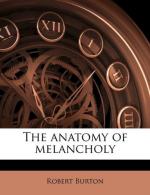“no painter, no graver, no carver can express virtue’s lustre, or those admirable rays that come from it, those enchanting rays that enamour posterity, those everlasting rays that continue to the world’s end.” Many, saith Phavorinus, that loved and admired Alcibiades in his youth, knew not, cared not for Alcibiades a man, nunc intuentes quaerebant Alcibiadem; but the beauty of Socrates is still the same; [4571]virtue’s lustre never fades, is ever fresh and green, semper viva to all succeeding ages, and a most attractive loadstone, to draw and combine such as are present. For that reason belike, Homer feigns the three Graces to be linked and tied hand in hand, because the hearts of men are so firmly united with such graces. [4572]"O sweet bands (Seneca exclaims), which so happily combine, that those which are bound by them love their binders, desiring withal much more harder to be bound,” and as so many Geryons to be united into one. For the nature of true friendship is to combine, to be like affected, of one mind,
[4573] “Velle et nolle ambobus idem, satiataque toto Mens aevo”------
as the poet saith, still to continue one and the same. And where this love takes place there is peace and quietness, a true correspondence, perfect amity, a diapason of vows and wishes, the same opinions, as between [4574] David and Jonathan, Damon and Pythias, Pylades and Orestes, [4575]Nysus and Euryalus, Theseus and Pirithous, [4576]they will live and die together, and prosecute one another with good turns. [4577]_Nam vinci in amore turpissimum putant_, not only living, but when their friends are dead, with tombs and monuments, nenias, epitaphs elegies, inscriptions, pyramids, obelisks, statues, images, pictures, histories, poems, annals, feasts, anniversaries, many ages after (as Plato’s scholars did) they will parentare still, omit no good office that may tend to the preservation of their names, honours, and eternal memory. [4578]_Illum coloribus, illum cera, illum aere_, &c. “He did express his friends in colours, in wax, in brass, in ivory, marble, gold, and silver” (as Pliny reports of a citizen in Rome), “and in a great auditory not long since recited a just volume of his life.” In another place, [4579]speaking of an epigram which Martial had composed in praise of him, [4580]"He gave me as much as he might, and would have done more if he could: though what can a man give more than honour, glory, and eternity?” But that which he wrote peradventure will not continue, yet he wrote it to continue. ’Tis all the recompense a poor scholar can make his well-deserving patron, Mecaenas, friend, to mention him in his works, to dedicate a book to his name, to write his life, &c., as all our poets, orators, historiographers have ever done, and the greatest revenge such men take of their adversaries, to persecute them with satires, invectives, &c., and ’tis both ways of great moment, as [4581] Plato gives us to understand.




